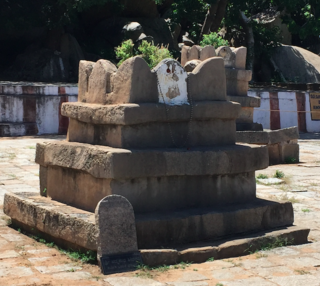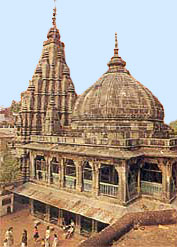
Raghavendra Tirtha was a Hindu scholar, theologian and saint. He was also known as Sudha Parimalacharya. His diverse oeuvre include commentaries on the works of Madhva, Jayatirtha and Vyasatirtha, interpretation of the Principal Upanishads from the standpoint of Dvaita and a treatise on Purva Mimamsa. He served as the pontiff of matha at Kumbakonam from 1621 to 1671. Sri Raghavendra Swamy was also an accomplished player of the Veena and he composed several songs under the name of Venu Gopala. His shrine at Mantralayam attracts lakhs of visitors every year.

Vyāsatīrtha, also called Vyasaraja or Chandrikacharya, was a Hindu philosopher, scholar, polemicist, commentator and poet belonging to the Madhwacharya's Dvaita order of Vedanta. As the patron saint of the Vijayanagara Empire, Vyasatirtha was at the forefront of a golden age in Dvaita which saw new developments in dialectical thought, growth of the Haridasa literature under bards like Purandara Dasa and Kanaka Dasa and an amplified spread of Dvaita across the subcontinent. Three of his polemically themed doxographical works Nyayamruta, Tatparya Chandrika and Tarka Tandava documented and critiqued an encyclopaedic range of sub-philosophies in Advaita, Visistadvaita, Mahayana Buddhism, Mimamsa and Nyaya, revealing internal contradictions and fallacies. His Nyayamruta caused a significant stir in the Advaita community across the country requiring a rebuttal by Madhusudhana Saraswati through his text, Advaitasiddhi. He is considered as an amsha of Prahlada in the Madhva Parampara.

Sri Jayatirtha, also known asTeekacharya, was a Hindu philosopher, dialectician, polemicist and the sixth pontiff of Madhvacharya Peetha from. He is considered to be one of the most important seers in the history of Dvaita school of thought on account of his sound elucidations of the works of Madhvacharya. He is credited with structuring the philosophical aspects of Dvaita and through his polemical works, elevating it to an equal footing with the contemporary schools of thought. Along with Madhva and Vyasatirtha, he is venerated as one of the three great spiritual sages, or munitraya of Dvaita. Jayatirtha is considered an incarnation of Indra with avesha of Adi Sesha in the Madhva Parampara.

Padmanabha Tirtha was an Indian Dvaita philosopher, scholar and the disciple of Madhvacharya. Ascending the pontifical seat after Madhva, he served as the primary commentator of his works and in doing so, significantly elucidated Madhva's terse and laconic style of writing. His pioneering efforts in expanding upon the Dvaita texts to uncover the underlying metaphysical intricacies was taken forward by the 14th Century philosopher, Jayatirtha. Padmanabha is also credited with disseminating the philosophy of Dvaita outside the Tulunadu.

Sadh Vaishnavism, , is a denomination within the Vaishnavism—Bhagavata tradition of Hinduism. Sadh Vaishnavism was founded by thirteenth century philosopher-saint Madhvacharya, who developed the Tattvavada (dvaita) Vedanta sub-school of Hindu philosophy.

Raghuttama Tirtha ; IAST:Śrī Raghūttama Tīrtha), was an Indian philosopher, scholar, theologian and saint. He was also known as Bhavabodhacharya. His diverse oeuvre include commentaries on the works of Madhva and Jayatirtha. He served as the fourteenth pontiff of Madhvacharya Peetha - Uttaradi Math from 1557 to 1595, which he occupied, with remarkable distinction for thirty-nine years. He is considered to be one of the most important seers in the history of Dvaita school of thought. His shrine at Tirukoilur attracts thousands of visitors every year.

Vidyadhiraja Tirtha was a Hindu philosopher, dialectician and the seventh pontiff of Madhvacharya Peetha and served as peetadhipathi from.

Satyapriya Tirtha was an Indian Hindu philosopher, guru, scholar, yogi, mystic and the pontiff of Uttaradi Math, a math dedicated to Dvaita philosophy. He was the successor of Satyavijaya Tirtha and the 24th pontiff of Uttaradi Math from 1737—1744.

Shri Vidyadhisha Tirtha, was an Indian philosopher, scholar, theologian, saint and dialectician. He served as the sixteenth pontiff of Uttaradi Math from 1619 to 1631. He is considered to be one of the important stalwarts in the history of Dvaita school of thought on account of his sound elucidations of the works of Madhvacharya, Jayatirtha and Vyasatirtha. He is also the most celebrated pontiff of Uttaradi Math after Padmanabha Tirtha, Jayatirtha and Raghuttama Tirtha.

Satyavara Tirtha was an Indian philosopher, scholar and the pontiff of Uttaradi Math, a math (mutt) dedicated to Dvaita philosophy. He was the successor of Satyasandha Tirtha and the 27th pontiff of Uttaradi Math since Madhvacharya, the chief proponent and the one who rejuvenated this Dvaita philosophy and served the pontificate from 1794 to 1797.

Satyabhinava Tirtha was a Hindu philosopher, scholar, theologian and saint. He served as the pontiff of Shri Uttaradi Math from 1673 to 1706. He was the 21st in succession from Madhvacharya. He is known for his great works Durghata Bhavadipa on Bhagavata Tatparya Nirnaya and Mahabharata Tatparya Nirnaya Vyakhyana, a commentary on Mahabharata Tatparya Nirnaya of Madhva.

Satyanidhi Tirtha was a Hindu philosopher, scholar and saint. He served as the pontiff of Shri Uttaradi Math from 1638–1660. He was the 19th in succession from Madhvacharya. Satyanidhi Tirtha ruled the pontificate with a remarkable distinction. His life was a saga of supreme spiritual achievements.

Satyadhyana Tirtha was an Indian Hindu philosopher, scholar, yogi, mystic, theologian and saint. He was the 38th pontiff of Uttaradi Math and served the pontificate from 1911-1942. He was considered most active and zealous pontiffs of 20th century. He was an untiring propagandist, the best debater of his days and almost a terror to his adversaries in philosophical polemics. It was at his initiative and inspiration that a splendid Marathi translation of Madhva's Brahmasutra Bhashya, with the Tatvaprakashika of Jayatirtha was published for the benefit of a large number of followers of Madhvacharya in Maharashtra. He made extensive tours all over India, held disputations and published polemical tracts and phamplets in many languages in North and South India for free distribution. He started, Sriman Madhva Siddhanta Abhivruddhikarini Sabha around 1905-06 and registered in 1930 to promote the study of Sanskrit literature and philosophy, particularly the study of Dvaita Philosophy, to hold meetings and conferences of Madhva scholars.

Bidarahalli Yadupati Acharya was an Indian Hindu scholar in the Dvaita Vedānta tradition. He is the follower of Uttaradi Math and the disciple of Vedesa Tirtha.

Bhavani Narayanrao Krishnamurti Sharma, commonly known as B. N. K. Sharma or B. N. Krishnamurti Sharma, was an Indian writer, scholar, professor, and Indologist. Sharma was a professor and Head of the Department of Sanskrit in Ruparel College, Bombay from (1953–1969). Sharma was one of the foremost exponents of Madhvacharya's school of Dvaita Vedanta. B. N. K. Sharma learned the art of debates under Satyadhyana Tirtha of Uttaradi Math. Sharma travelled along with Satyadhyana Tirtha from, learned all philosophical knowledge from him and also used to rectify his doubts from Satyadhyana Tirtha.

The Abhinava Gada (Sanskrit:अभिनवगदा);, is a Sanskrit work on Dvaita philosophy written by Satyanatha Tirtha. It is a refutation work for the theological controversies provoked by Appayya Dikshita's on Madhva Siddhanta.

Abhinava Chandrika ;, is a Sanskrit work on Dvaita philosophy written by Satyanatha Tirtha. It is a lucid adaptation of the well-known commentary on Jayatirthas Tattvaprakāśikā, which is a commentary on Madhvacharya's Brahma-sutra bhashya. It runs to 12,600 granthas and is magnum opus of Satyanatha Tirtha.

The Abhinava Tandava also called as Abhinava Tarkatandava (Sanskrit:अभिनवताण्डवम्) ), is a Sanskrit work on Dvaita philosophy written by Satyanatha Tirtha.

Chandrika Bindu, is a Sanskrit work on Dvaita philosophy written by Satyapriya Tirtha. It is a lucid adaptation of the well-known commentary on Vyasatirthas Tatparya Chandrika or Chandrika, which is a commentary on Tattva Prakasika by Jayatirtha, which in turn is a commentary on Madhva's Brahma Sutra Bhashya.

Narayanacharya, was an Indian scholar and philosopher of Dvaita Vedānta tradition. He was the disciple of Vedavyasa Tirtha of Uttaradi Math and is the most celebrated name in the annals of the great dvaita-advaita debate. Narayanacharya is notable for his work Advaita Kalanala, which is a refutation work to Madhvamatamukhamardana of Appayya Dikshita. Indologist B. N. K. Sharma writes, "The Advaita Kalanala is a scathing criticism of the Madhvamatamukhamardana of Appayya. The carping criticisms and bitter personal attacks of the Dikshita are vigorously returned by Narayana. He loses no opportunity to pay the critic in his coin and with compound interest. The tone of the work is thus retaliatory and bitingly sarcastic". Sharma also writes, "Narayanacharya was one of the fiery champions of the Dvaita school, that rose to defend it against the slashing attacks of Appayya Dikshita and others". American historian Anthony Grafton and classicist Glenn W. Most considered the work Advaita Kalanala along with the Abhinava-Gada of Satyanatha Tirtha as a new mace which broke the heads of non-dualists like Appayya Dikshita.













